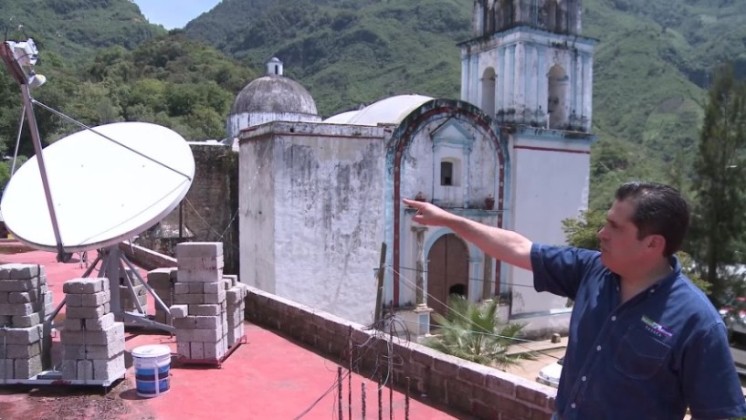
Hernán Garza of Telecomm shows the satellite equipment that offers people in Santiago Nuyoó in southwest Oaxaca access to mobile banking.
We’ve been filming a story about reaching the last mile in southwest Oaxaca.
Santiago Nuyoó, population 2000, is in the Sierra Mixteca. (See our photo album on Facebook.) It’s a two-hour drive over dirt roads to the nearest town, Tlaxiaco, with the nearest bank, and cellphone coverage.
Nearly 30 million people—a quarter of the Mexican population—live in rural communities, most with no access to cell phone coverage, or formal financial services. The low population density, remoteness, and a hilly topography that makes these areas hard to reach means that private network operators haven’t extended their networks to these areas, and aren’t likely to anytime soon. At one point, we were thinking of calling our film “Waiting for Carlos Slim.”
On the margins, with no basic infrastructure, communities like Santiago Nuyoó are almost entirely left out of Mexico’s economic growth and progress. The people here are mostly indigenous, and although most speak Spanish, many also speak their native language, Mixteco.
Breaking the equation with local voice
Telecomm, the state-run telegraph agency, thinks that with its network of 1600 rural branches they can create a new model that will bring basic mobile services and bank accounts into the hands of rural inhabitants.
By charging market rates for local voice and basic banking services, Telecomm believes they can offer a viable business that will spur economic development in these rural communities.
And they see Santiago Nuyoó as the chance to prove their case.
In this short clip, Hernán Garza, Director of Basic Financial Services for Telecomm, explains how a combination of satellite for SMS, and cellular for local voice promises to make it possible to provide both local voice and mobile banking services sustainably.
Telecomm needs to prove not only that the technology will work, but also that the people will adopt the service–and that they will pay for it.
We talked to many people in the town and in the surrounding areas, and one thing is clear: they find the service very convenient and they are prepared to pay for it.
Use cases
There are a number of distinct use cases (CGAP research identified six different user-types). For merchants like Claudia Santiago who runs a gift store in town it means her customers can pay her using person-to-person payments. She no longer displays a list of debtors in her store—people who haven’t paid her simply because of the lack of cash moving around in the area. Today they transfer money using their cellphone and pay a 3 pesos charge (about 23 cents) per transaction. “For me, it’s very practical,” says Claudia.
Mario Santiago is a local entrepreneur. He cooks rotisserie chicken at home that he then sells in the settlements dotted throughout the countryside around Santiago Nuyoó. He told us the new service helps his business, and means he doesn’t have to deal with finding change.
Reyna López, who lives a two-and-a-half-hour walk from Santiago Nuyoó in Plan de Zaragoza, said: “I spend less because I don’t have to pay my transportation, or lose the whole day walking.” She’s a single mother, and she uses the service to send money to her daughter who lives with relatives in Santiago Nuyoó during the week to go to school.
Others use the mobile service less frequently, but still find it useful for saving, depositing cash into their accounts at the Telecomm office in Santiago Nuyoó.
Eighteen months into the pilot, 80% of families are using the phones, and over half are using the payment service regularly—a very high number by international standards. “Now we can’t imagine our lives without a phone,” said Claudia.
The pilot in Santiago Nuyoó has proven usage. Next, Telecomm needs to prove the business case so they can replicate it in other rural communities.
They recently started offering bill payments for services like satellite TV that cost anywhere between 3 and 8 pesos, or about 60 cents. They’ve also started charging a 100 pesos monthly fee for local voice calls. None of the locals seem to have any qualms about paying these rates for the services. They are clear about the value proposition, and know that even with those fees the service saves them a considerable amount of time and money.
The Last Mile
In the end, we decided to call our film “The Last Mile.” But this is far from the end of the story.
The possibilities are enormous. Hernán Garza, who is leading this project for Telecomm, has big ambitions—ambitions to extend this service to 4,000 similar communities in rural Mexico–about 19 million people, and to extend its social impact, for example by using the phones to deliver health messages for pregnant women, vaccination messages, education announcements, and other public service messages.
Watch the 8-minute film, The Last Mile: going mobile in rural Mexico.
